In the previous module we explored Creative Commons licenses, and how to apply these to resources and media. In this module we will be exploring Open Educational Resources (OER) and what makes a resource open. We will also look at how you can find, adapt, revise, remix and create and share OER.
Let’s begin by looking at an early definition of OER from Hewlett Foundation:
“OER are teaching, learning, and research resources that reside in the public domain or have been released under an intellectual property license that permits their free use and re-purposing by others. Open educational resources include full courses, course materials, modules, textbooks, streaming videos, tests, software, and any other tools, materials, or techniques used to support access to knowledge.”
William and Flora Hewlett Foundation (via the Internet Archive)
In this widely used definition there is both an emphasis on openly licensed materials or those in the public domain. Additionally, it emphasizes that OER not only includes more traditional resources like textbooks and modules, and it also more expansive including: test banks, tools, videos and software.
The following video developed by the Council of Chief State School Officers provides a short overview of OER.
Now that we have a shared definition of OER, let’s take look at some of the initiatives and drivers that have informed the OER movement.
Free Open Source Software Movement
The open educational resources movement initially stems from the open-source software movement, whose outputs are often referred to as FOSS – Free Open Source Software or FLOSS – Free/Libre Open-Source Software; in the later, the word “libre”, has been added to underscore that this is software that is free of restrictions. Open-source software is software that is freely licensed to use, copy, and change in any way as the source code is openly shared so that people are encouraged to voluntarily improve the design of the software.
In the early days, computer software was open-source, allowing people to modify and improve software for their own purposes, a practice that had been established in academia; however, as software creation costs increased and software companies came to the market by the 1980s legal restrictions began to be imposed on the software, thus eliminating the collaborative element within the community. The FOSS movement began as a response to the locking down of software with some major initiatives like the GNU project, the GNU Manifesto, and the GNU General Public License, to what we see now with Github.

Dig Deeper
To learn more about the GNU project and the GNU Manifesto, read The GNU Manifesto Turns Thirty.
Open Education Developments
As the open-source software work was occurring, other groups began investigating applying the open ethos to other kinds of information sources.
The MERLOT project began in 1997 with the California State University Center for Distributed Learning. MERLOT was modelled after the National Science Foundation-funded project, “Authoring Tools and An Educational Object Economy (EOE).” MERLOT was the first major open education repository that provides access to mostly free, online curriculum materials for use by higher education faculty and students.
Similarly, during this time arXiv was being developed, as Joanne Cohn and Paul Ginsparg recognized the problem of sharing physics preprint articles through email and developed a central mailbox repository for academics to share e-prints. This initial sharing was focused more on simplifying workflows but is identified as the first step toward open access in scientific publishing.

license under the Public Domain
For open education, there were two major initiatives that have had a great impact on academic institutions moving toward open education. Rice University created CONNEXIONS (now OpenStax), a web-based platform to facilitate sharing education resources. Now OpenStax, the platform helps to develop and share open textbooks. The second major initiative was MIT’s OpenCourseWare Initiative, which launched in 2001 with a goal of openly and freely sharing educational materials from MIT’s courses. MIT OpenCourseWare shares course materials online in what the MIT Council called a desire to contribute to the “shared intellectual commons,” and through the financial support of the Mellon Hewlett Foundation they’ve provided over two thousand courses free online (their website listed 2400 as of 2021).
These individual projects had a huge impact on open education practice in academic institutions, but larger policy initiatives also were being developed, more firmly rooting open into how institutions developed their larger education strategies.

Dig Deeper
To learn more about the history of OER, review: A Brief History of Open Educational Resource and OER – A Historical Perspective.
Organization Supports for OER
Due in part to the success of MIT’s OpenCourseware, the UNESCO Forum on the Impact of Open Courseware for Higher Education in Developing Countries convened in July 2002 to foster awareness of open education resources, promote understanding, secure development, and discuss strategies and policies on OER. Of great importance was the adoption of a final declaration in which participants
“expressed their … wish to develop together a universal educational resource available for the whole of humanity, to be referred to henceforth as Open Educational Resources.”(UNESCO, 2002, p. 6)
As policies and declarations were, in some ways, codifying open as a strategy for education and resource outputs, organizations and foundations were supporting these efforts through funding and organization around open practices.
The Mellon Hewlett Foundation is a non-partisan granting organization that provides grants to research universities contributing to public knowledge, to performing arts centres engaging local diverse communities, and to grassroots organizations working on international development. Since 2018, it has provided over $170 million US to develop OER, starting initially with the MIT OpenCourseWare project. The foundation provides grants to major universities (MIT, Harvard, Carnegie-Mellon, Open University, Rice), and has funded projects to support OER development, including OERCommons at the Institute for the Study of Knowledge Management in Education (ISKME).
In addition to funding, organized practices in open licensing were stimulated by the founding of Creative Commons in 2001. Creative Commons was created to support the legal use of distributing, adapting, modifying, and sharing of open resources (see the Creative Commons module for more about CC’s history). CC has become the standard of licensing for open education content and is considered foundational to the work of open education.
In the more recent years since 2012, there have been some major advancements in open education initiatives at the world level with the United Nations Educational, Scientific and Cultural Organization (UNESCO) Paris OER Declaration, where the term open educational resources were founded and UNESCO states were encouraged to participate in the creation, use, and research around OER.
In November 2019, UNESCO adopted five OER Recommendations:
- Building capacity of stakeholders to create access, use, adapt and redistribute OER;
- Developing supportive policy;
- Encouraging inclusive and equitable quality OER;
- Nurturing the creation of sustainability models for OER; and
- Facilitating international cooperation.
A Timeline of events that informed the development of OER
We have included a timeline below that shows some of the events informing the OER movement. It is important to acknowledge that the movements and events on the time represented only a strand of OER and open education history.

Dig Deeper
To learn more about UNESCO statements on open education and OER, review: Forum on the impact of Open Courseware for higher education in developing countries final report.
